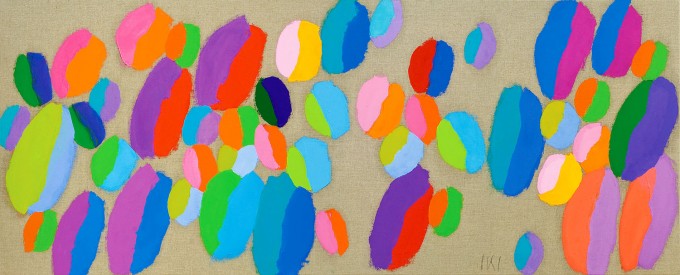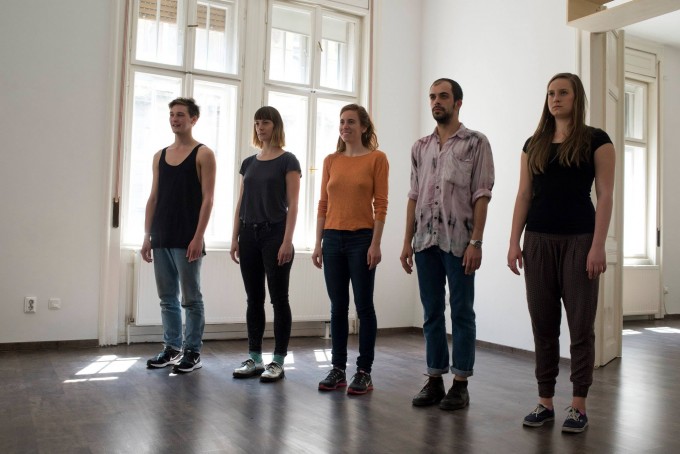When three years ago, in his position as the President of the Hungarian Academy of Arts1 (HAA), György Fekete first appalled the general public with his untenable exclusionary statements verging on anti-Semitism, everything around this political power-engendered institution seemed clear. By today, however, lots of things have become blurred. In spite of the radical and spectacular protests that were organized on several occasions by the group of “Free Artists” against the increasing reach of the HAA’s power, in spite of all the images of artistic resistance posted on Facebook and on various online portals2, the machinery of the HAA, stuffed with billions of forints of public money, still forges onwards relentlessly. Since then, the Hungarian state has also transferred ownership of the Műcsarnok/Kunsthalle to the HAA, with the result that “the most significant venue and symbolic space for contemporary art in Hungary,”3 became as of January 1, 2013 the HAA’s property lock, stock and barrel. From that point on, the Műcsarnok has lost its position as an internationally renowned and relevant venue for contemporary Hungarian art and culture, and been downgraded into a showroom for HAA’s anachronistic outlook on culture and for its mediocre membership. The disrupting effect of this development was not confined within the walls of the Műcsarnok. The spirit (not to say, genie) of the National Salon, as was revived by the peremptory vision of the HAA’s President to the greatest pleasure of the mediocrities, has intruded and nestled in every corner of the contemporary art scene. The idea of National Salons, just like this exhibition, presents in a condensed form everything that has nothing to do with the creation of contemporary culture with a lively, critical, and experimental artistic horizon and which could also be meaningful in an international context. In vain do the majority of the art scene’s actors delude themselves into thinking that everyone will be able to continue their work smoothly, and that by simply ignoring the existence of the HAA, or at the most, by trying to be a bit more resourceful in obtaining support from sources other than the National Cultural Fund4, things will go on just as usual. Unfortunately, that is not the case.

Given that an overly long time has passed since the first shocking statements and inadmissible institutional makeovers were made, the inevitable process towards compromise has taken on an inexorable momentum, extending from smaller or larger agreements, through existentially perhaps justifiable compromises, to appeasements based on well-calculated financial interests. The “System of National Cooperation,” as the government of Viktor Orbán named itself in 2010, has polarized every segment of society, not excluding the sub-system of contemporary culture and art. As the most effective means to serve this end, the HAA has not only divided the community of artists and cultural workers owing to the circumstances of its founding and continuous institutional existence, but each of its programs, open calls, or invitations also imply yet another provocative pressure to make a statement: are you with or against us? It is illusory to think that one may parry such battlefield logic: no room has been preserved for neutral positions. Everyone who has been an active agent or participant in the contemporary art scene thus far will sooner or later face the constraint of taking sides and experience the sense of helplessness arising in such situations, as when an artist or a curator is trying to find rational and professional, or moral and emotional, clues; for such clues are hard to find. There are no examples or models to help one assess the validity of different reactions to clear-cut situations; there is no personal experience that could serve as a reference point regarding the sense and value of adherence to one’s conviction; no standard of measurement has managed to emerge during the last few decades, in line with which one could make comforting personal decisions. In the rare instances of the voicing of self-justifications for compromising decisions made for the sake of maintaining one’s existential security, the ammunition for the explanation is drawn from the false stock of arguments rooted in the Kádár “consolidation” era following the crushing of the Hungarian Revolution of 1956.
Actors in the contemporary art scene make an effort to form their own individual systems of explanations, defining sophisticated thresholds as to what falls within and what falls outside of acceptable limits of tolerance when considering an invitation or open call, but the personal indicators of the levels of involvement or absence remain undetectable. This results in the air of frustrated evasiveness lingering in the rooms of the Műcsarnok throughout the National Salon and its accompanying events.
The National Salon is the most effective means to divide the contemporary art scene, and at the same time, it is an obvious failure. It is effective, as those who have accepted the invitation to take part in the exhibition spectacularly identified themselves with the concept of art represented by the HAA, which means that the position of this public body has been exponentially legitimated by gaining the “best names:” “See for yourself: they are also exhibiting their works here with us.” At the same time, it is a failure, as it has become clear that the HAA lacks ammunition in terms of content and aesthetics. Nothing can be detected in the exhibition space that would attest to what was put forward in the Salon’s communications on the level of sonorous and anachronistic rhetoric; namely, that the exhibition would be a “comprehensive” presentation “seeking to afford an overview” and make “relevant phenomena” visible.

With the assistance of politicians and through legislative enactment, it is possible to create an organization out of nothing and endow it with overall prevalence, overturning the previous, organically developed system of balance; it is possible to redraw the old map of ownership and replace decision makers with new, reliable, and loyal adherents; but it is impossible to create a new canon in this way, even if this three-year long forward march seems to be directed to this end.
By structurally eliminating the artistic field’s autonomous hierarchy of values, which used to function only according to its internal logic, by displacing the artistic set of values and value statements, as manifested in the functioning of major public institutions outside of artistic discourse, the HAA has practically brought all partakers of the contemporary art scene into a situation directly dependent on and subject to the prevailing political, ideological, and personal power relations. It is no wonder that instead of liberating creative energies, a sense of desperate and unfruitful apathy has taken over the lives of our contemporaries. Such a state of mind, in turn, has a fundamental impact on the current dispositions related to the psychology of creativity, not to speak of the upcoming generations’ professional socialization or of the prospects for a continued reproduction of contemporary art. (It must be by no coincidence that the recently launched MA program in curatorial studies at the Hungarian University of Fine Arts was terminated just a few weeks ago. After all, it is nothing but logical: a curatorial position representing professional autonomy and intellectual freedom is nothing but a disturbing factor in this state-controlled cultural-political system.)

It must be stated that the National Salon truly presents the current state of contemporary art in a “comprehensive manner,” albeit not in complete unison with the original intention of those who envisioned and realized it. It attests to a state of confusion, internal division, and perplexity that is an overall sentiment among those who are affected in any way by this situation. It is impossible to presage, not to speak of predicting, how long this state of affairs will prevail and at what rate all the partakers, both beneficiaries and victims, will be (in a metaphoric sense of the word) “amortized” in the meantime. Nevertheless, it can be said for certain that with the passing of time, intrepid resistance triggered by moral indignation will be eroded; it will be more and more difficult to pursue artistic activities in the increasingly narrowing physical and symbolic spaces; acting on the courage of one’s convictions in regard to certain values will lose importance; and it will become easier and easier to justify any compromise dictated by existential constraints and alignment with the given realities. This situation is startlingly familiar to the generations over fifty. How sad, that those in their thirties are now made to familiarize themselves with what was termed “consolidation” in Hungary in the 1960s, and “normalization” in Czechoslovakia following 1968. And we are all aware of how it ended up.
The text was originally published on tranzitblog.hu in Hungarian in July 2015.
Translated by Andrea Szekeres
About the author
Barnabás Bencsik is a Budapest-based art historian and curator, initiator and head of ACAX | Agency for Contemporary Art Exchange, former director of the Ludwig Museum – Museum of Contemporary Art, Budapest.
Notes:
- Originally a private association founded by mostly conservative artists as a counter-academy in opposition to the Széchenyi Academy of Letters and Arts (established by the Hungarian Academy of Sciences in 1992), the Hungarian Academy of Arts (in its Hungarian abbreviation, MMA) was established as a public body in 2011 according to the decision of the Hungarian Parliament. Its position in all major decision-making procedures in culture is also assured by the new Fundamental Law of Hungary, i.e., the constitution. The HAA’s increasing power has triggered several protests by Hungarian artists and arts professionals engaged in contemporary art. For a detailed analysis of Hungarian cultural policy (dated December 2014) see Compendium of Cultural Policies and Trends in Europe (Hungarian profile: www.culturalpolicies.net/down/hungary_122014.pdf). ↩
- For information on the protests, see NEMMA (No MMA) / Autonomy for Art in Hungary!, which also contains a short history of the HAA https://nemma.noblogs.org/2012/12/07/a-short-history-of-mma/. ↩
- Quoted from an Announcement of the Board of the Hungarian section of AICA, The antidemocratic makeover of the cultural scene in Hungary, December 2012. ↩
- The major institution for the financing of Hungarian culture, the National Cultural Fund (NKA) was established in 1993 as a semi-autonomous institution in charge of financing cultural projects, with a quarter of its budget at the discretion of the minister in charge of culture. Its strategic role is currently being challenged by the Hungarian Academy of Arts. According to a recent amendment to Act XXIII/1993 on the National Cultural Fund, a third of its professional boards will be delegated by the HAA, a third by the ministry in charge of culture (at present, the Ministry of Human Resources, officially dubbed in English as the Ministry of Human Capacities), and only a third by professional organizations. (Previously, a half of the board members were delegated by the Ministry, and a half by professional organizations.) ↩



